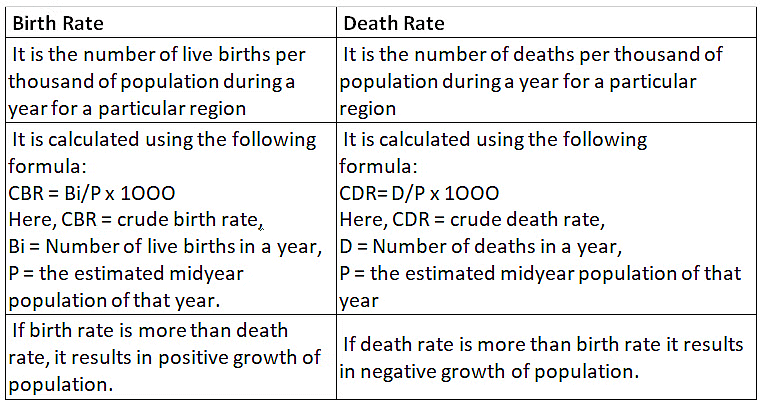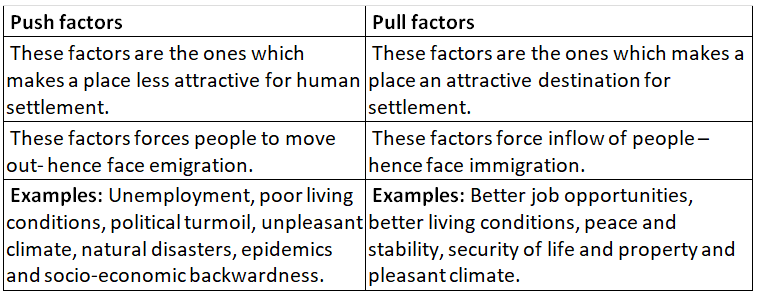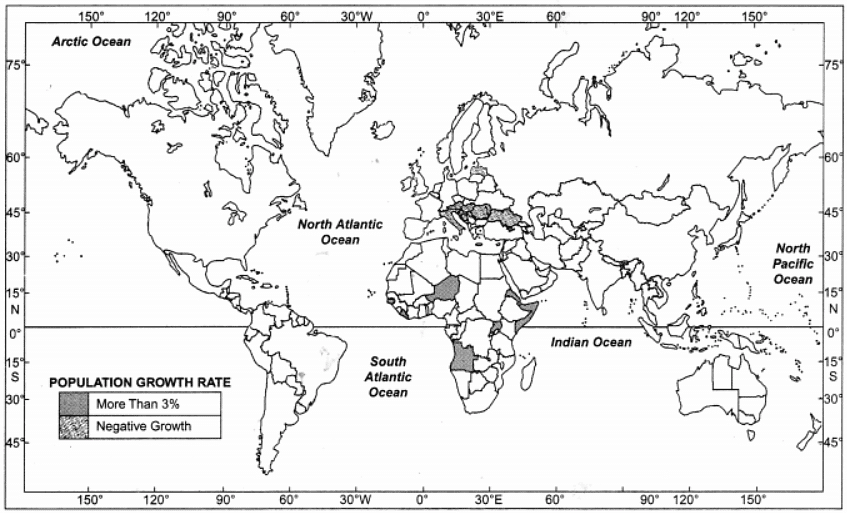NCERT Solutions for Class 11 Geography - The World Population
Q1: Choose the right answer from the four alternatives given below.
(i) Which one of the following continents has the highest growth of population?
(a) Africa
(b) South America
(c) Asia
(d) North America
Ans: (c)
(ii) Which one of the following is not an area of sparse population?
(a) The Atacama
(b) South-east Asia
(c) Equatorial region
(d) Polar regions
Ans: (b)
(iii) Which one of the following is not a push factor?
(a) Water shortage
(b) Medical/educational facilities
(c) Unemployment
(d) Epidemics
Ans: (b)
(iv) Which one of the following is not a fact?
(a) Human population increased more than ten times during the past 500 years.
(b) Nearly 80 million people are added to the world population each year.
(c) It took 100 years for the population to rise from 5 billion to 6 billion.
(d) Population growth is high in the first stage of demographic transition.
Ans: (c)
Q2: Answer the following questions in about 30 words.
(i) Name three geographical factors that influence the distribution of population.
Ans: Three geographical factors that influence the distribution of population are:
- Availability of water
- Landforms
- Climate
(ii) There are a number of areas with high population density in the world. Why does this happen?
Ans: This happens due to the following factors:
- Geographical factors such as adequate availability of water, plain landforms, comfortable climate and fertile soils attract people.
- Economic factors such as mining and industrial activities generate employment, urbanisation and industrialisation also attract a large number of people.
- Social and Cultural Factors: People tend to move away from places where there is social and political unrest.
(iii) What are the three components of population change?
Ans: Three components of population change are birth rate, death rate and migration.
Q3: Distinguish between:
(i) Birth rate and death rate.
Ans: (ii) Push factors and pull factors of migration.
(ii) Push factors and pull factors of migration.
Ans:

Q4: Answer the following questions in about 150 words.
(i) Discuss the factors influencing the distribution and density of population in the world.
Ans: The various factors that influence the distribution and density of population in the world are:
- Geographical Factors:
- Availability of water: People prefer to live in areas where fresh water is easily available. Water is used for drinking, bathing and cooking – and also for cattle, crops, industries and navigation.
- Landforms: People prefer living on flat plains and gentle slopes because such areas are favourable for the production of crops and to build roads and industries.
- Climate: An extreme climate such as very hot or cold deserts are uncomfortable for human habitation. Areas with a comfortable climate, where there is not much seasonal variation attract more people.
- Soils: Fertile soils are important for agricultural and allied activities. Therefore, areas which have fertile loamy soils have more people living on them.
- Economic Factors
- Minerals: Areas with mineral deposits attract industries. Mining and industrial activities generate employment therefore these areas are densly populated.
- Urbanisation: Cities offer better employment opportunities, educational and medical facilities, better means of transport and communication.
- Industrialisation: Industrial belts provide job opportunities and attract large numbers of people.
- Social and Cultural Factors: Some places attract more people because they have religious or cultural significance. People tend to move away from places where there is social and political unrest. Many a times governments offer incentives to people to live in sparsely populated areas or move away from overcrowded places.
(ii) Discuss the three stages of demographic transition.
Ans: The three stages of demographic transition are:
- The first stage has high fertility and high mortality because people reproduce more to compensate for the deaths due to epidemics and variable food supply. The population growth is slow and most of the people are engaged in agriculture where large families are an asset. Life expectancy is low, people are mostly illiterate and have low levels of technology.
- Fertility remains high in the beginning of second stage but it declines with time. This is accompanied by reduced mortality rate. Improvements in sanitation and health conditions lead to decline in mortality. Because of this gap the net addition to population is high.
- In the last stage, both fertility and mortality decline considerably. The population is either stable or grows slowly. The population becomes urbanised, literate and has high technical know-how and deliberately controls the family size.
Map Skill
On the outline map of the world, show and name the following.
(i) Countries of Europe and Asia with negative growth rate of population.
Ans:  (i) Countries of Europe and Asia with negative growth rate of population are:
(i) Countries of Europe and Asia with negative growth rate of population are:
Latvia, Estonia, Russia, Ukraine, Saudi Arabia, Albania, Bulgaria, Oman, Croatia, Slovania, Czech Republic, Germany, and Portugal.
Project/Activity
(i) Has someone in your family migrated? Write about her/his place of destination. What made her/him migrate?
Ans: My grandfather is a migrant. The reason of migration was partition of the country.
(ii) Write a brief report on the distribution and density of population in your state.
Ans: The density of population in our city Delhi is 9294 persons per sq. km.
|
271 videos|870 docs|231 tests
|
FAQs on NCERT Solutions for Class 11 Geography - The World Population
| 1. What factors contribute to the growth of the world population? |  |
| 2. How does the world population impact the environment? |  |
| 3. What are the challenges associated with an aging world population? |  |
| 4. How does the distribution of the world population vary across different regions? |  |
| 5. What are some strategies for managing the world population growth sustainably? |  |

















